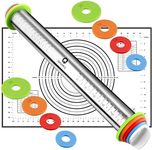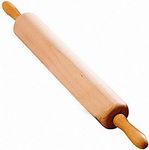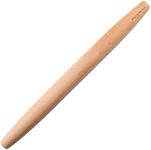Buying Guide for the Best Rolling Pins
Choosing the right rolling pin can make baking and cooking much easier and more enjoyable. The best rolling pin for you depends on what you like to bake, how much control you want, and your comfort level. Understanding the different types and features will help you pick a rolling pin that feels good in your hands and works well for your favorite recipes.MaterialRolling pins come in various materials such as wood, marble, stainless steel, and silicone. The material affects the weight, how the pin handles dough, and how easy it is to clean. Wooden pins are classic and provide a natural feel, but they may require more care. Marble pins are heavier and stay cool, which is great for pastry doughs, but they can be harder to handle for long periods. Stainless steel and silicone are easy to clean and don’t absorb odors, but they may not offer the same traditional feel. Think about what you bake most often and how much maintenance you’re willing to do when choosing the material.
Type (Style)There are two main styles: the classic rod (French) and the handled (American) rolling pin. French pins are straight rods, sometimes tapered at the ends, and give you more control over pressure and direction, making them great for delicate doughs. Handled pins have a cylinder with handles on each end, which can be easier for beginners and are good for rolling out large, even sheets of dough. If you like precision and versatility, a French pin might suit you. If you prefer comfort and ease, a handled pin could be better.
LengthRolling pins come in different lengths, usually ranging from about 10 to 20 inches. Shorter pins are easier to maneuver and are good for small batches or tight spaces, while longer pins can roll out larger sheets of dough more quickly. If you mostly bake cookies or small pastries, a shorter pin may be enough. For pies, pizzas, or large pastries, a longer pin will help you work more efficiently.
WeightThe weight of a rolling pin affects how much effort you need to roll out dough. Heavier pins can flatten dough with less pressure from you, which is helpful for tough doughs, but they can be tiring to use for long periods. Lighter pins give you more control but require more effort to roll out thick doughs. If you have limited strength or bake often, consider a weight that feels comfortable to hold and use for your typical baking tasks.
Surface TextureSome rolling pins have a smooth surface, while others may have textured or patterned surfaces for special effects. Smooth pins are best for most baking needs, as they won’t stick to dough as much and are easy to clean. Textured pins are mainly for decorative purposes, like making patterns on cookies or pasta. Choose a smooth pin for general use, and consider a textured one only if you want to create specific designs.
Ease of CleaningHow easy a rolling pin is to clean depends on its material and design. Wooden pins should not be soaked in water and may need to be oiled occasionally, while marble, stainless steel, and silicone pins can usually be washed more easily. If you want something low-maintenance, look for a pin that can be cleaned quickly and doesn’t require special care.
















